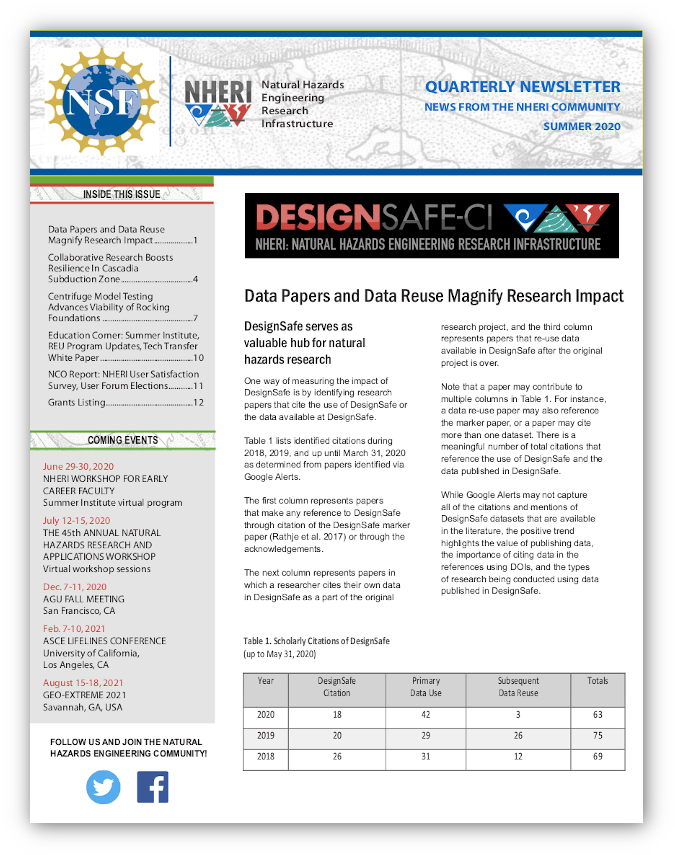Collaborative Research Boosts Resilience in Cascadia Subduction Zone
Published on June 15, 2020
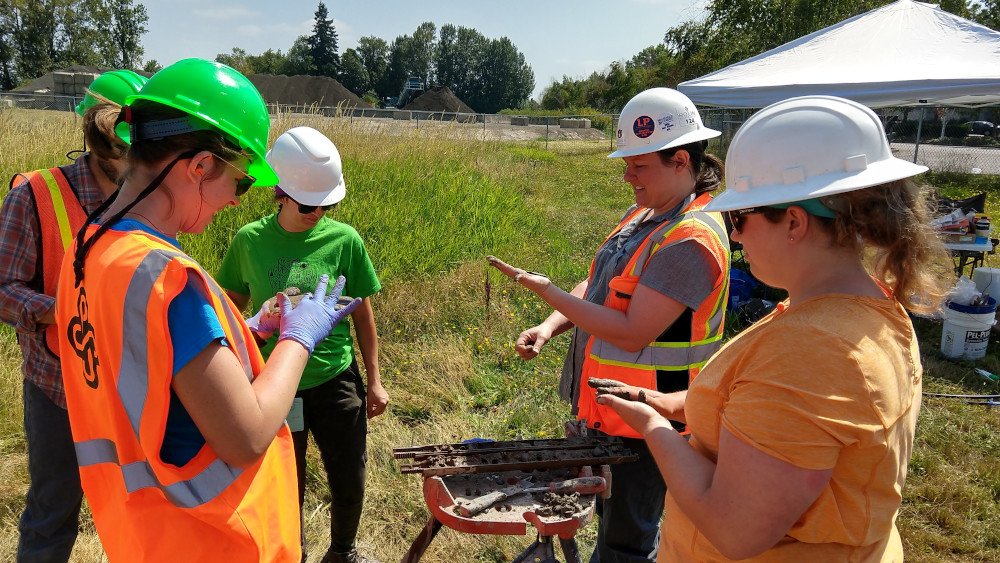
Dr. Diane Moug (CoPI from PSU) logging the retrieved soil samples with graduate students from Portland State University and Arizona State University. From left to right: Diane Moug (PSU CoPI), Melissa Preciado (PSU graduate student), Elizabeth Stallings Young (ASU graduate student), Kayla Sorenson (PSU graduate student).
Bio-mediated soils improve liquefaction resistance in the north Portland area
As detailed in Oregons 2013 Resilience Plan, the likelihood of an M9 Cascadia earthquake occurring during our lifetimes, and the consequences of such an earthquake, are significant.
Similar to other North American coastal regions with loose alluvial soils, the Portland, Oregon, area is prone to liquefaction during a strong earthquake. Liquefaction occurs when intense ground-shaking increases water pressure in saturated cohesionless and low plasticity soils, causing the soil to lose strength and stiffness suddenly and turn temporarily to a viscous fluid. In places such as Christchurch, New Zealand, and Palu, Indonesia, liquefaction has caused catastrophic infrastructure losses in recent earthquakes.
OVERVIEW
Geotechnical engineers from Portland State University are focused on improving vulnerable soils around Portland, which is located uncomfortably near the off-shore Cascadia Subduction Zone. Principal investigator Arash Khosravifar and co-PI Diane Moug, both assistant professors in the PSU Department of Civil and Environmental Engineering, are evaluating a new ground improvement technique for mitigating liquefaction.
The improvement technique employed was developed by Arizona State University (ASU) researchers at the Center for Bio-mediated and Bio-inspired Geotechnics (CBBG), a National Science Foundation Engineering Research Center. Called microbially induced desaturation, or MID, it is a cost-effective, low-impact ground improvement method that could be used relatively easily under existing structures. The method works by encouraging the growth of gas producing bacteria in soil, thereby desaturating the soil and reducing the potential for triggering of liquefaction.
To test the MID ground improvement technique, the project deployed the mobile shaker equipment available from the NHERI equipment facility at the University of Texas at Austin (NHERI@ UTexas).
Field data from the project suggests that the MID method can substantially desaturate silty soils prone to liquefaction in the Portland area.
If the desaturation proves to be well-distributed and persistent, the technique promises to keep Portland area soils stable, even during intense ground shaking, with low environmental impact and expense.
PROJECT IMPACT
Field data collected in this multidisciplinary, multi-institutional project suggests that the MID method can substantially desaturate the silty soils that are prone to liquefaction in the Portland area. If the induced desaturation can be shown to be well distributed and persistent, the technique promises to keep Portland area soils stable, even during intense ground shaking, with low environmental impact and expense.
This is particularly important in Portland where important infrastructures are located on potentially liquefiable soils. The Portland International Airport and the Critical Energy Infrastructure (CEI) hub, where 90% of the states fuel supplies are handled, are located on liquefaction-prone grounds.
Other mitigation efforts are more expensive, and a lot of times you cant apply them to existing structures, says Khosravifar. This could be a game-changer in mitigating liquefaction risk not just in Portland, but all over the world.
If validated, the MID technique may well prevent worst-case scenarios dreamed up for an M9 earthquake in the region: For instance, soils liquefying under the Critical Energy Infrastructure (CEI) hub could collapse and rupture fuel tanks, leading to fires and an environmental disaster in the nearby Willamette River not to mention the loss of vital fuel supplies.
Usually, improving soils under existing structures is simply too expensive to consider. But instead of vibrating or pounding the liquefiable soil into a stiffer, and more resistant state (the conventional means for mitigating liquefaction), the CBBG-developed technology subtly uses the existing microorganisms in the soil. CBBG researchers designed the treatment procedure and provided technical support during treatment and monitoring for this project.
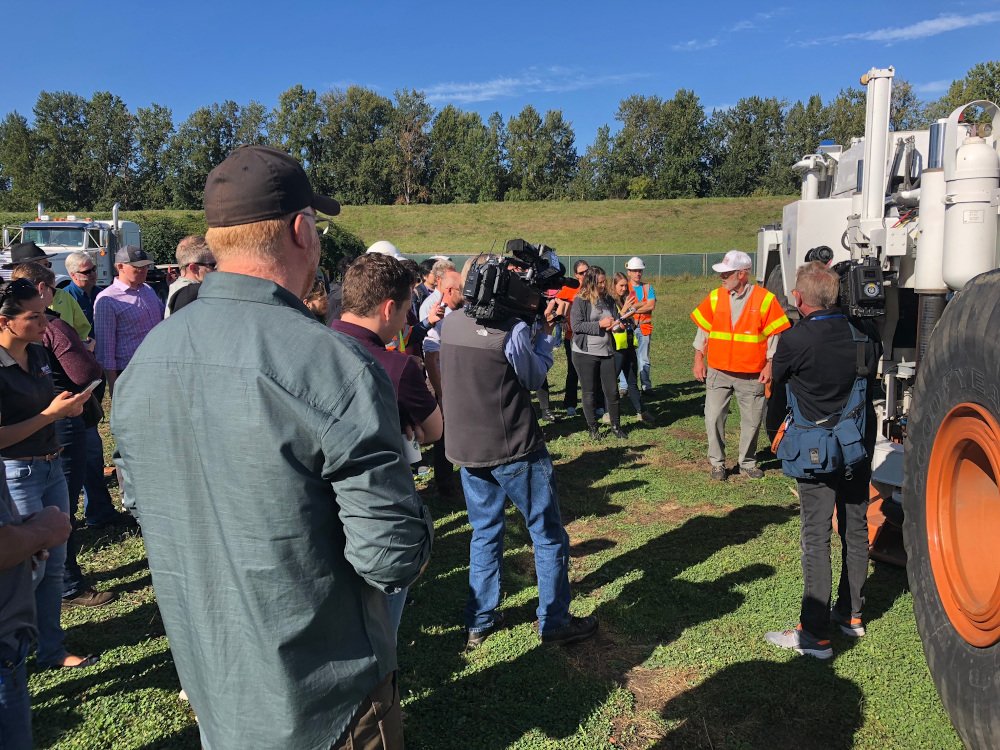
Dr. Ken Stokoe, director of NHERI@UTexas and UT CoPI, explaining in situ field shaking with TREX during a field demonstration on September 10, 2019 at the field trial site by the Portland airport.
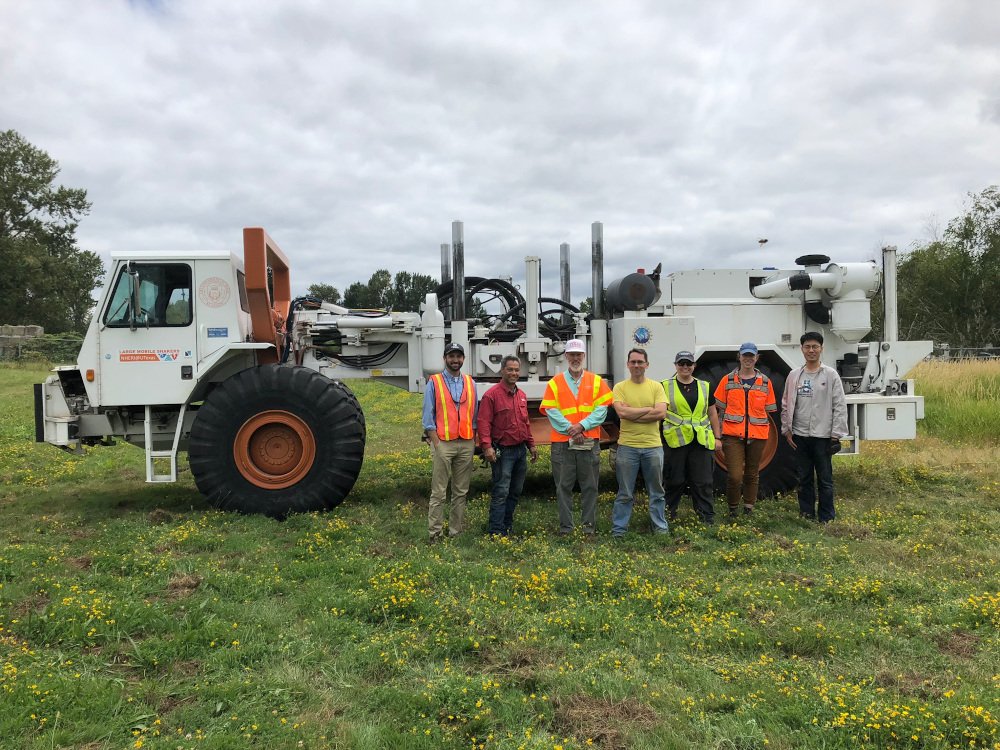
Researchers from Portland State University and NHERI@UTexas at the field trial site by Portland airport. From left to right: Arash Khosravifar (PSU CoPI), Andrew Valentine (technician NHERI@UTexas), Ken Stokoe (UT CoPI and NHERI@UTexas director), Robert Ken (technician NHERI@UTexas), Kayla Sorenson (PSU graduate student), Diane Moug (PSU CoPI), and Benchen Zhang (UT graduate student).
RESEARCH METHODOLOGY
One of the two sites selected for study was a 62-acre habitat restoration area owned by Portland General Electric in Portland known as Harborton, which is located near Oregons CEI hub. The similarity of soil-types provided an opportunity to determine if the MID soil remediation treatment could address one of Oregons most serious resiliency concerns. The second site was situated near the Portland airport.
At both sites, engineers fertilized a patch of ground by injecting nutrients down a pipe 6 to 20 feet below the surface. As the nutrients seep into the soil, they stimulate the growth of nitrate-reducing bacteria native communities of microbes that, as they metabolize, produce two environmentally benign gases, nitrogen and carbon dioxide. Like yeast in bread dough, this process creates gas pockets in the soil. The compressibility of the gas inhibits water pressure build up in the soil a precondition for liquefaction.
Desaturation is significantly cheaper than conventional ground improvement techniques because a small volume of gas is sufficient for liquefaction resistance and there is a growing body of evidence showing that desaturation is persistent with our method, says Edward Kavazanjian, director of the CBBG.
To assess the state of the treated soil before and after the MID ground improvement, sensors were placed in the ground to measure the biochemical conversion and degree of saturation. The two mobile shakers from NHERI@UTexas, T-Rex and Rattler, made geophysical measurements and simulated a series of earthquakes. The UTexas team also held a workshop to illustrate the use of mobile shakers for monitoring stiffness-based ground improvements.
At one of the two sites, the team installed cross-hole sensors which measure the speed at which compressional waves, or P-waves, travel through the ground. The P-wave velocity is directly related to the soil saturation, and regular measurements of the P-wave velocity have enabled long-term monitoring of the process performance. Before and after the ground was treated with the MID process, the team measured and analyzed the collected P-wave data, which showed a significant reduction in P-wave velocity, indicating that the microbial process effectively desaturated the soils.
T-Rex and Rattler were used to induce earthquake-like ground motions in the treated soil strata, during which water pressures and soil deformations were measured. Unfortunately, the induced shaking was not quite strong enough the generate significant pore pressure in the liquefiable soil strata.
My co-PI, Diane Moug, and I enjoyed working with the UT team and CBBG researchers. Our workshop-field demo on September 10-11, 2019, using the T-Rex shaker was a great hit, says Khosravifar.
The workshop attracted a lot of local engineers and media, which was great for raising awareness about the liquefaction-prone soils in our region and our efforts to address the problem.
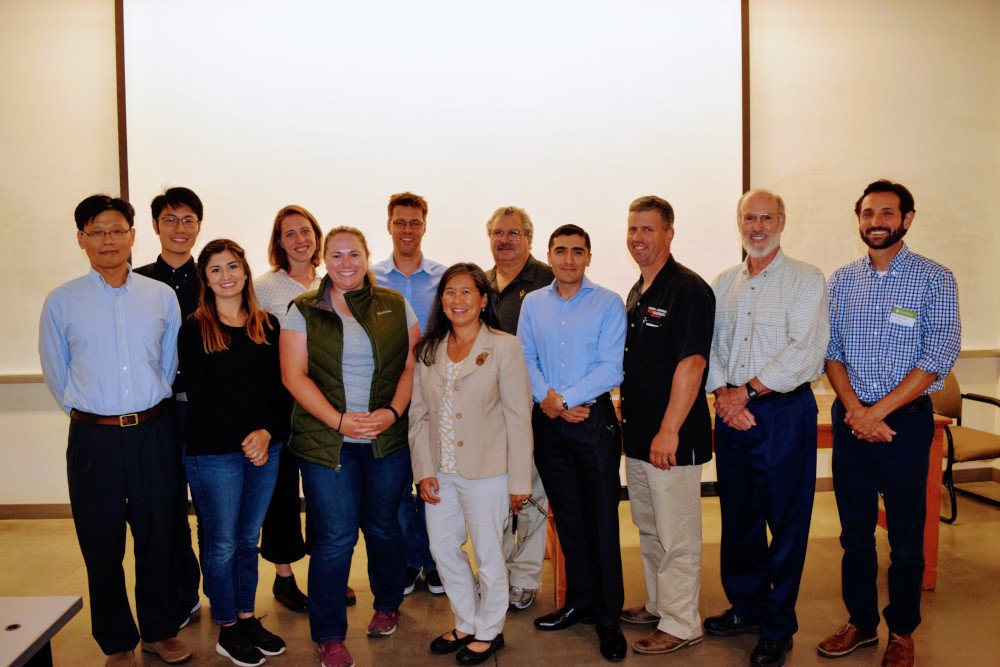
Project team at the project/NHERI workshop on September 10, 2019 in Portland, OR. From left to right: Farnyuh Menq (operation manager, NHERI@ UTexas), Benchen Zhang (graduate student, UT), Melissa Preciado (graduate student, PSU), Diane Moug (CoPI, PSU), Kayla Sorenson (graduate student, PSU), Leon van Paassen (CBBG), Yumei Wang (Oregon Department of Geology and Mineral Industries), Edward Kavazanjian (director of CBBG), Soheil Kamalzare (Condon Johnson and Associates), Dominic Parmantier (Condon Johnson and Associates), Ken Stokoe (director of NHERI@ UTexas), and Arash Khosravifar (CoPI, PSU).
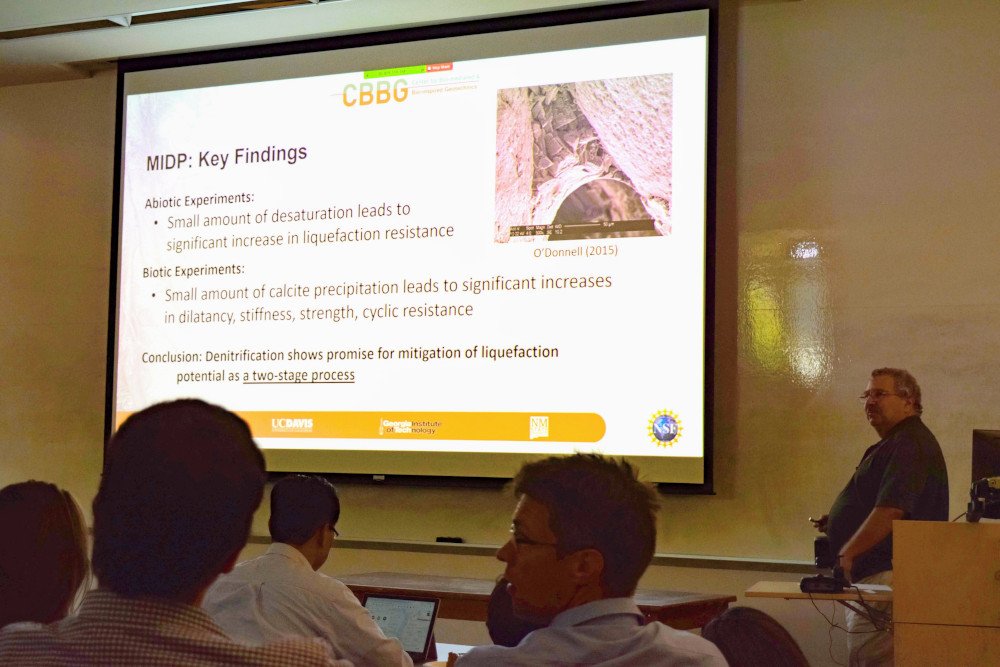
Dr. Edward Kavazanjian, director of the Center for Bio-mediated and Bio-inspired Geotechnics (CBBG) at Arizona State University, presenting at the project/NHERI workshop on September 10, 2019 in Portland, OR.
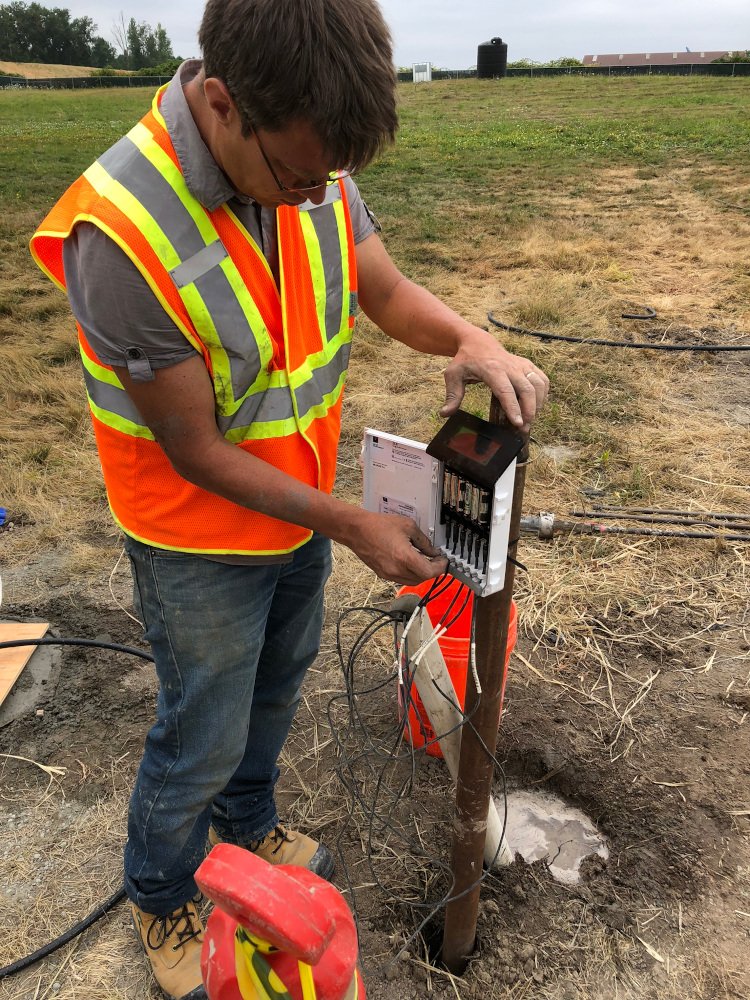
Dr. Leon van Paassen from the Center for Bio-mediated and Bio-inspired Geotechnics (CBBG) at Arizona State University installing a solar-powered wireless data logger for embedded sensors that measure hydraulic conductivity and water content of the soil in situ.
THE FUTURE
The NHERI@UTexas team trained PSU graduate students on how to collect and analyze measurements from cross-hole seismic wave instruments installed in the treatment zone. The project team at PSU is now monitoring the persistence of the desaturation and is making plans to return to the site with T-Rex and implement measures to enhance the level of shaking to demonstrate the effectiveness of desaturation in mitigating liquefaction.
CROSS-DISCIPLINARY PARTNERSHIPS
The PSU research project, the CBBG, and the NHERI@UTexas mobile shaker equipment are all funded by the National Science Foundation. The collaboration demonstrates a growing convergence of research funded by NSF.
The study also included collaborators from the Oregon Department of Geology and Mineral Industries, Portland General Electric, Portland Bureau of Transportation and Portland Water Bureau, and industry partners including Geosyntec Consultants, Condon and Johnson Associates and ConeTec.
NHERI Quarterly
Summer 2020
Data Papers and Data Reuse Magnify Research Impact
Collaborative Research Boosts Resilience in Cascadia Subduction Zone
Centrifuge Model Testing Advances Viability of Rocking Foundations
Education Corner: Summer Institute, REU Program Updates
New Technical Transfer White Paper Available Online
NCO Report: NHERI User Satisfaction Survey, User Forum Elections
NHERI Grants Listing for Q4 2019 and Q1 2020
